
Five important FAQ about blue-green algae for dog owners
Blue-green algae isn’t actually an algae at all, but a bacteria; one from a family of bacteria called cyanobacteria. Many dog owners will have already seen blue-green algae at some point without knowing what it was, but despite being quite distinctive when in full blue-green bloom, blue-green algae isn’t always visible to the naked eye at all.
Even when you can see it, it may not have a blueish tinge; pea green, greenish-brown, and pale to mid-brown clumps or specks in the water can all be blue-green algae too.
Blue-green algae can be acutely dangerous to dogs that ingest it, which can occur if they either drink from water containing it, or swim or paddle in water and then lick the water from their coats. Blue-green algae has a toxic effect on the dog’s liver, and can make dogs that ingest it acutely ill; it is also fatal in short order in a large number of cases too.
Even if you don’t think blue-green algae is a problem around where you live, if you walk your dog in areas where there is still, fresh water – including ponds, lakes, canals, reservoirs, and so on – and your dog either likes to swim, paddle, or drink the water, it is important to learn a little bit about blue-green algae, to recognise and mitigate any potential risks.
This article will answer five important questions from dog owners about blue-green algae. Read on to learn more.
Do dogs have to drink blue-green algae for it to harm them?
Dogs have to ingest water that has blue-green algae present in it before it can potentially hurt them. But it is important to interpret this statement correctly! For instance, a dog could drink seemingly clear water with no visible signs of blue-green algae in it; but the bacteria might be present in the water even if not in visible form, and so could still make your dog ill.
Also, it is not just deliberately drinking from water containing blue-green algae that poses a risk to dogs. A dog that paddled or swum in water containing blue-green algae bacteria (once more, possibly invisible) is then likely to lick their wet coat, ingesting the water and once more, being at risk of illness.
My dog leapt into water with visible blue-green algae in it, what should I do?
Being aware of what blue-green algae looks like when visible and/or knowing about a local watercourse that is apt to contain it is really useful to avoid it. But dogs are not always predictable, and so if your dog leapt into water that contained or may contain blue-green algae, what should you do?
Firstly, recall them and get them out of the water immediately. Put them on their lead and try to stop them from licking their coat, taking them straight home and walking briskly to reduce the chances of them licking themselves. When home, bathe them immediately; in the first instance taking care to thoroughly rinse the coat, before then shampooing them and bathing them more comprehensively.
If you know or suspect they drank any water or licked their coat, call your vet as soon as you get home, so that they can either advise you on monitoring your dog or assessing the risk factors, tell you to take them to the clinic.
Even if you’re more or less confident that your dog did not ingest any of the water, monitor them carefully for any signs of sickness and don’t take chances if you have any concerns.
Is blue-green algae dangerous to people?
Yes, blue-green algae isn’t only dangerous to dogs, but people too. As we’re highly unlikely to drink or ingest water that has blue-green algae in it, you don’t tend to hear about cases of blue-green poisoning in people; but it can still be a problem.
If someone swam in or fell into water containing blue-green algae, accidental swallowing of some of the water is reasonably likely to happen. This can potentially make the person in question acutely ill, and while it is rare, has led to liver and even brain damage in people who swallowed sufficient quantities of affected water.
Even skin contact with blue-green algae can cause an irritating skin rash; and the ingestion of a small amount may result in headaches, sickness, and digestive upset.
This means that you do need to take care to avoid affected water coming into contact with bare skin when caring for your dog if they have been exposed to a potential source of blue-green algae.
Can I find out about blue-green algae hotspots and so avoid them?
In many local areas, particularly where blue-green algae appears regularly, there may actually be signs present to indicate this; but never assume that a lack of signs means the water is safe. Local vets and other dog owners will often be able to tell you of spots to avoid too; but again, this doesn’t mean that an unflagged area is not a risk too.
I think I’ve seen blue-green algae but the area doesn’t seem to be known for it; is there anything I should do?
The Environment Agency actually monitors and maps cases of blue-green algae and in some cases, arranges for the above-mentioned cautionary signage to be placed to alert others.
If you’ve spotted or think you’ve spotted blue-green algae in a watercourse or area that isn’t widely known for it, you can report blue-green algae to the Environment Agency for them to investigate.



